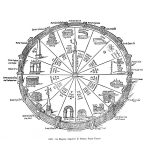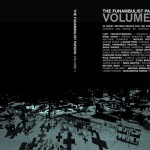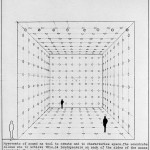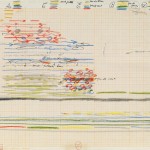30 years are passed since a historic exhibition took place at the Centre Pompidou (specifically at the Centre de Création industrielle). Curated by Jean François Lyotard and Thierry Chaput, Les Immatériaux (1985) was later identified as an inauguration of the Post-Modern, and an important milestone in the history of the relationship between art and technology.
Originally titled “Matériaux Nouveaux et Création“, the exhibition was completely reorganised after the arrival of the philosopher J.F. Lyotard who wanted to demostrate the emergence of a new materiality due to the advancements in telecommunication technology. The concepts of postmodernity, modernity, materialisation and dematerialisation were investigated while proposing a new sensibility of material being, thanks to the emphasis given to the exposure of upcoming phenomena such as new media, communication, net.art and thus preceding the artistic debates of 1990s and 2000s around the interactive work and the need for the creation of expanded and immaterial locus for art.


From the press release (1985): (translation by Socks):
“At the Centre Georges Pompidou, the CCI seeks to stage what changes. Seems like the changes, as always, come from outside. From the working conditions, from everyday life, from the media. What a difference, they say, respect the lives of our fathers! But it is in our heads that all this changes : ways of feeling, watching, hearing, language, the intimacy of the body, etc. “Les Immatériaux “is a kind of dramaturgy placed between the completion of a period and the anxiety for an emerging era at the dawn of postmodernity, and in this sense, is part of a philosophical and artistic project. It seeks to awaken a sensitivity which is already there, to feel the uncanny in the familiar, and how difficult it is to get an idea of what is changing. A whirlwind of stopped paths where you will draw your own. Sites of bio-genetics and visual arts, architecture and astrophysics, of music and food, of physics and clothing, a maze of linguistical machines, of habitats and photography, industry and law. Miles of invisible wiring. And our questions: reality, material, equipment, matrix of meaning, and who is the author? “

Today the symposium “30 Years after Les Immatériaux: Science, Art, and Theory, at Leuphana University of Lüneburg, 2014.” is dedicated to the 30th anniversaty of this exhibition:
The exhibition wanted to demonstrate the emergence of a new materiality produced by the advancement in telecommunication technology. The prefix im- announced a break from the modern conception of material, language, body, science, and art. The exhibition has shown how the desire of modernity produced a negation of itself and passed to a new cultural form which Lyotard named postmodern. The exhibition was hence also an inauguration of the postmodern. This symposium wants to trace the historical discourse both within the exhibition and in the intellectual environment of the late 1970s and early 80s that put art, science and theory into question, and it wants to reflect on the new material conditions brought up by digital technologies in the last 30 years. For example, in art, we see the rise and fall of new media art; in science, the triumph of computer simulation is displacing the epistemology of laboratory science, and we can observe the birth of the universe and humankind on a screen; in theory, in the face of the the rise of digital humanities, media philosophy aims to respond to the separation between culture and technology in the long occidental history.
If Les Immatériaux proposed a new sensibility of material being, and if this sensibility demanded a new response from art, science and theory, we want to ask 30 years after that milestone of the postmodern, what kind of sensibility and response is appropriate towards our current material condition? For some thinkers, the modern could be seen as the celebration of the abundance of energy and material (Sloterdijk 2004) which produced a spleen of the obsolescence of history. We can also understand the postmodern as the celebration of disorientation and uncertainty as well as a second kind of melancholia arose after the energy crisis and financial crisis (Bourriaud 2009). Culture needs to response to the crisis generated in itself (Greenberg 1979), while this response is always two folds or pharmacological (Derrida 1972, Stiegler 2011). 30 years after Les Immatériaux, we have an hypothesis that the postmodern is also a symptom. On one hand the development of aesthetics in life-style surpasses the commodity fetish described by Marx, a process that Frederic Jameson (1991) calls the logic of late capitalism; on the other hand, it creates a new sentiment of loss, the destruction of difference between rural and urban, work and play, functionalism and perception, art and art market, biopower and biopolitics. One cannot identify where one is, due to the removal of places by globalisation which is driven heavily by marketing aesthetics and economic growth. The postmodern presents itself as a symptom of our time.
Indeed, a new sentiment is also present at our time in terms of scientific progress, globalisation, social networks, as well as wars, the Occupy movement, global warming, financial crisis, all of which brought to our eyes and ears via optical cables and digital gadgets. Our hypothesis for the symposium is the following: if modernity designates a will of mastery, and postmodernity celebrates the sense uncertainty and disorientation, then we demand a new vision of orientation, a re-orientation. The word re-orientation has two senses here. Firstly with regard to the historical discourse of the occident and orient, we can observe that this relation has been further distorted by globalisation and modernisation. For example, Asian countries are the copy-cats of the West which embeds a dis-orientation in a geopolitical sense. At the same time, the search for a god (Heidegger 1967) or Japanese Zen (Lyotard 1987) as a remedy of the West’s own intoxication. Re-orientation is also an effort to produce a dialogue that has never taken place, instead of political conflicts and economical exchanges. Secondly the re-orientation as new discourses of human progress, of aesthetics, of technological development, that move away from the post- including postmodern and post-human, from the second death of man to a new vision in art, science and theory. The symposium invites scientists, artists and theorists to participate in two days of discussion and performance.


A great collection of original documents (among which: the Catalogue, Vol. 2: Album et Inventaire and the Press pack) is held at Monoskop.org and at the page of Centro Pecci Prato. (The links are copied at the end of this post).
To these original texts we’d like to contribute with the article written in 1985 for Domus by French art critic and cultural philosopher Pierre Restany.
Pierre Restany: Immatériax: let us be leavened with Lyotard (in «Domus», 662 (June 1985), p. 60-63)
Entering the fifth floor of the Pompidou Centre is an astonishing experience. One had never seen anything like it, in the attic-chapel where high masses for the dead are usually celebrated: the world of darkness and silence (the sound track is housed in the headphone which vou are given at the entrance), the mysterious kingdom of microwaves and ultraviolet, laser beams and integrated circuits, screens and diagrams. “In the initial project, the angle of attack rested primarily on technoscience. What we had to formulate could have been summed up in a few words. First, the deep intuition that what matters by now in materials is the “soft”. And this other idea: “material is first of all emptiness”. We wanted therefore to describe, or at any rate suggest, the challenge launched by technoscience to the ancient origins of culture. So says Thierry Chaput, the man responsible for the “Immatériaux” at Beaubourg, animator of the C.C.I. team, who asked the philosopher Jean-Francois Lyotard to recreate, by means of a labyrinth-laboratory of thirty “zones”, the vaporous darkness of Plato’s cave in the post-modem version. Originally the project turned on the theme of “New materials and creation”; but the breath of technoculture literally dematerialized it. Both in its staging and in its practical verification, the e exhibition route multiplies the proof and the tests of relativity: relative perceptions, ambiguous identities, body-nonbody, forms non-forms, solid voids, hidden variables, invisible decor, stripped lights, unrepresentable images, simulated depths, reversed references, forgotten soils, evanescent texts, objects lost, time deferred… It is in fact the entire man/technology ratio that is questioned, and the same occasion is taken to pose the entire problem of technoculture. The third industrial revolution, that of the year 2000 and of the Post-Modern era, is presented as a radical mutation of our sensibilities. The more the complexity of our surrounding software is developed, the farther our perceptive zones will reach. The symbiosis of man and machine passes, in an initial, paramount phase, through the intelligence of technological devices and their immediate finality.
Man’s survival depends upon his capacity to invent the rules of the game of new situations created by technoscience. By gaining a point, man re-establishes or invents the rules to his advantage.
Such is the law of the existential game the assertion being in the universe of the relative.
The visitor to the “Immateriaux” will thus gather, in disorder, an incalculable quantity of vivid psycho-sensorial impressions on the borderline between reality and fiction, realization and illusion. Some will be infinitely agreeable, other less.
The visitor will not quickly forget the sound of blood in the entrance hall, Artaud’s cry to the equivalent derm, or the voice of Yves Klein talking about the architecture of air. And when sorting out his memories he will be unable to prevent himself thinking of a limitless future. He will have felt a bit stronger and seen a little farther ahead. The whole monochrome adventure will have unfolded in a flash in his brain and before his eyes.
This exhibition is a school of sensibility and an alarm signal. We emerge from it a little more conscious of ourselves and of the imminent mutation of our kind. The “soft” approach to the world is not confined to the stammering caricatures of new design; it is a matter of the heart and of the head, as Yves Klein prophetically said. That is the revelation: once this basic idea is perceived, everything else appears relative, beginning with relativity itself. One forgets the kitsch effects of the mosquito-nets, the arbitrary choice of reference-documents (especially on the subject of art), and the confusion of certain rooms. Never mind if the technology is not always up to the situation and if these super-intelligent little machines turn out to be unduly fragile. What does matter is the ecstasy, the bottle is of little importance after that. Let us be leavened with Lyotard. That is the best way of exorcising the present ghosts of our immediate future.
Here follows a selection of pages from the Catalogue/Inventaire Vol.2 :
























































A dedicated page on Les Immatériaux with lots of linked original documents and reviews at Monoskop.org.
Another rich page at the Centro Pecci Prato.





[…] http://socks-studio.com/2014/07/16/les-immateriaux-an-exhibition-of-jean-francois-lyotard-at-the-cen… […]